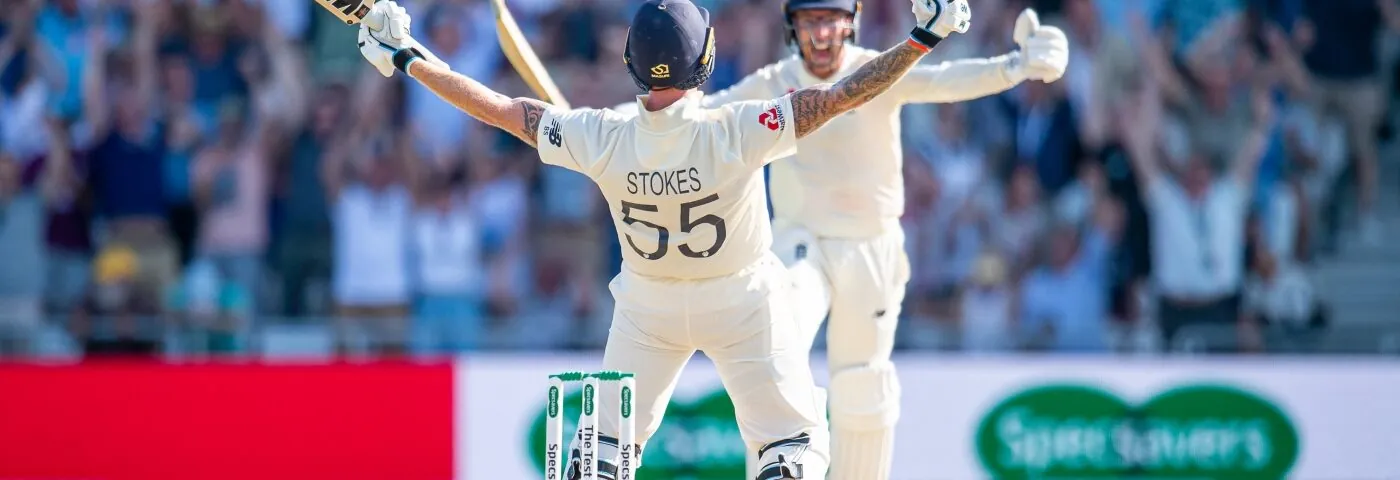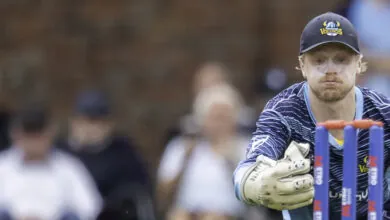by Paul Edwards
Perhaps the folk who devise the schedule for the English cricket season possess a sense of occasion. Perhaps it is merely good fortune. Either way, this third Test against India will begin on the anniversary of the conclusion to the 2019 Ashes encounter at Emerald Headingley. You might recall it.
Specifically you might remember the Western Terrace rising like a great beast to acclaim a cover-drive played by a slim, muscular Cumbrian with the ability to take a day’s cricket and mould it much as a sculptor might shape clay. Two years later I still return to that Sunday afternoon and see Roy Kilner’s auditorium, normally a place of relative tranquility, reduced to civilised chaos as journalists with 200 Tests on their clocks strove to make sense of what they had seen and turn it into intelligible prose. Even now, when film of that game is shown on TV during rain-breaks I marvel anew and then realise with a start that I watched one of the best days in the history of Test cricket unfold. And such highlights were also shown quite a lot during lockdown.
Lockdown. Ah yes.
It’s fair to wonder how many people in Emerald Headingley that baking Sunday truly knew what a lockdown would involve. But as well as changing lives beyond conception pandemics also reshape language: roll-out, ramp up, biosecurity, social distancing, bubbles, facemasks, flattening the curve.
Yes, before you say it, we have heard enough of those things and we should now look forward to a Test the prospect of which has been made all the more appealing by the classic at Lord’s. Yet as I have travelled around England this season, watching cricket in empty stadia in April, in grounds with only a thousand spectators present in May, and finally in the company of a full house in St John’s Wood last week, I thought of a perfect Spring morning in 2020 when I phoned a member of Yorkshire’s communications team and told him with perfect honesty that at that moment I would pay ten quid just to sit in the press box for half an hour and look out on a deserted Headingley.
It may now be a cliché on stilts to suggest that one values what one has possessed only when it is removed but the last 18 months have offered us proofs we shall never forget. Perhaps we should remember that when we walk through the gates on the first day of this game and are asked to observe a protocol or two. If that’s tricky maybe we should think for a moment about why Ben Stokes won’t be at Headingley this week or how any of us might cope with spending six weeks confined to either our place of work or a hotel room. I love reading more than anyone I know but I’m also damn sure I’d struggle. Get well, Ben, but take your time.
There is little doubt that the Western Terrace will rise to Stokes once again when he next plays a Test at Leeds. But over the next few days I’m betting it will also stand to honour one of its own, a cricketer who is barely five months older than his friend but upon whom so much responsibility has already rested this summer. Over the final two days of the Lord’s Test I asked colleagues roughly where they would rank Joe Root’s 180 not out against India among recent Test centuries. I did so fully accepting that such questions can never have a precise answer. For all that analysts devise algorithms to decide the best innings of all time, such judgements are subjective. Calculations omit the human factor.
Some formidable innings were offered as rivals to Root’s century: VVS Laxman’s 281 against Australia in Kolkata, 2001; Ricky Ponting’s 156 against England at Old Trafford, 2005; Younis Khan’s 216 against England at The Oval, 2016. There are others and if you extend the timespan back into the 20th century, very many more. Before long someone will mention Victor Trumper, although it is unlikely to be the former England cricketer who was famously unsure which country Trumper represented. And our discussion reached its inevitable conclusion: we agreed that Root’s century was of the very highest class and fit to be placed among the ones I’ve mentioned.
The England captain will no doubt accept that the remainder of the Lord’s Test did not go so well for him. But even that should add to our anticipation. This Indian team is intent on proving they can be compared with West Indies of the 1980s or Australia in the 1990s. In order to frustrate that goal an England team lacking both Stokes and Jofra Archer will need to play some its very best cricket. I hope the challenge excites the rest of the side as much as it seems to have inspired their captain.
And of course there could be no better place to meet such a challenge than Headingley, a ground on which England have not beaten India since their short tour in 1967. Admittedly those 54 years take in only three Leeds Tests but they embrace an enormous amount of change in both Indian cricket and that country’s politics. In 1967 India’s team retained signs of an old aristocracy. The tourists were captained by the Nawab of Pataudi, whose century at Leeds was not enough to save his side from a six-wicket defeat. Geoff Boycott made 246 not out but was dropped from the team for the next game at Lord’s for showing, in Wisden’s phrase, a “lack of enterprise”. No doubt the regulars in the old football stand said something about that. The strength of the Indian attack was its three spinners but the weather was wretched in the early part of the season and Pataudi’s team went into the Test series weakened by injury and underprepared. In July they lost to Yorkshire by an innings at Bramall Lane, still a ground of treasured memories.
Before very long the recollections would be fond for Indian cricketers as well. In 1986 seven wickets for Roger Binny and a Dilip Vengsarkar century helped them to a 279-run victory and 16 summers later hundreds by Sachin Tendulkar, Rahul Dravid and Sourav Ganguly set up an innings win. Cricketers like Tendulkar and Virat Kohli are often seen as human emblem of an assertive country but the truth is that the stature of this cricket-mad nation has been growing since at least 1971, when they achieved their first series win in England. They depend less on spin bowling than they did half a century ago but that too reflects a fully mature awareness of what is required to win Tests overseas. Victory in a five-match series in England is their next objective and preventing them achieving that goal will be no less difficult than winning the Ashes.






